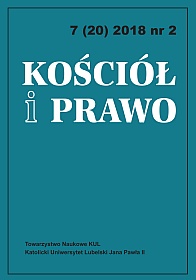Wpływ ustroju prawnego Kościoła łacińskiego na kształtowanie się aktualnego porządku prawnego katolickich Kościołów wschodnich na przykładzie urzędów protosyncela i syncela
Abstrakt
Urząd wikariusza generalnego powstał w Kościele zachodnim w XII w. Stopniowo jego władza umacniała się, aż stał się urzędem obligatoryjnym i głównym współpracownikiem biskupa diecezjalnego w zarządzie Kościołem partykularnym. Podczas przygotowań Soboru Watykańskiego II dostrzeżono potrzebę utworzenia nowej instytucji w strukturze Kościoła partykularnego. Obok urzędu wikariusza generalnego, ustanowiono urząd wikariusza biskupiego – nową funkcję o zbieżnej naturze prawnej i kompetencjach, ale przeznaczoną do wspierania biskupa diecezjalnego w poszczególnych aspektach jego działalności. W Kościele wschodnim powstał zwyczaj wybierania biskupów spośród zakonników. Biskupi chcieli nadal prowadzić życie monastyczne. Dobierali sobie współtowarzyszy, którzy zamieszkiwali wspólnie z biskupem w jego mieszkaniu. Tego towarzysza życia biskupa określano mianem synkellios, co w wersji łacińskiej uzyskało formę syncellus. Syncel był nie tylko współtowarzyszem życia biskupa, ale także wspomagał go w jego funkcjach, a nawet reprezentował biskupa w wielu sprawach kościelnych, przez co uzyskał znaczący wpływ w Kościele lokalnym.
Unie zawierane z Kościołami uznającymi zwierzchność Biskupa Rzymu, wiązały się także z przyjęciem przez nie łacińskiego systemu prawa kościelnego i form strukturalnych istniejących w Kościele zachodnim. Jednym z elementów tego dziedzictwa jurydycznego był urząd wikariusza generalnego. W motu proprio Piusa XII Cleri sanctitati i Kodeksie Kanonów Kościołów Wschodnich rozwiązania te zostały ugruntowane. Wprowadzono urzędy wikariusza generalnego i wikariusza biskupiego, nadając im starożytne nazwy syncela i protosyncela.
Bibliografia
Abramowiczówna, Zofia, red. 1960. Słownik grecko-polski. T. 2. Warszawa: Państwowe Wydawnictwo Naukowe.
Amadou, Richard. 1959. “Choréveques et Periodeutes.” L’Orient Syrien 4:48-73.
Chełmicki, Zygmunt, red. 1904-1916. Podręczna Encyklopedya Kościelna. T. 1-44. Warszawa: Księgarnia Gebethnera i Wolffa.
Chortyk, Oleg. 2002. „Status protosyncela w Kodeksie Kanonów Kościołów Wschodnich.” Praca magisterska, Katolicki Uniwersytet Lubelski Jana Pawła II.
Dola, Kazimierz. 1979. „Katalog arcybiskupów i biskupów rezydencjalnych eparchii polskich obrządku grecko-unickiego od Unii Brzeskiej (1596) do roku 1945.” W Historia Kościoła w Polsce. T. 2: 1764-1945, cz. 2: 1918-1945, red. Bolesław Kumor, i Zdzisław Obertyński, 301-27. Poznań-Warszawa: Pallottinum.
Dziub, Krzysztof. 2008. „Urząd wikariusza generalnego według Kodeksu Prawa Kanonicznego z 1983 roku.” Rozprawa doktorska, Katolicki Uniwersytet Lubelski Jana Pawła II.
Dziub, Krzysztof. 2009. „Elementy konstytutywne urzędu wikariusza generalnego.” W Mojemu Kościołowi wszystko! Księga Jubileuszowa ku czci Ks. Arcybiskupa Stanisława Nowaka Metropolity Częstochowskiego z okazji 25. rocznicy sakry biskupiej i posługi pasterskiej w Kościele częstochowskim, red. Stanisław Jasionek, 531-35. Częstochowa: Częstochowskie Wydawnictwo Archidiecezjalne Regina Poloniae.
Faris, John D. 1992. The Eastern Catholic Churches Constitution and Governance According to the Code of Canons of the Eastern Churches. New York: Saint Maron Publications.
Głódź, Sławoj Leszek. 2002. „Historia prac kodyfikacyjnych.” W Unitas in varietate. Materiały z międzynarodowej konferencji naukowej połączonej z prezentacją polskiego wydania Kodeksu Kanonów Kościołów Wschodnich, red. Leszek Adamowicz, 97-120. Lublin: Wydawnictwo Muzyczne Polihymnia.
Herbermann, Charles, ed. 1913. The Catholic Encyclopedia. Vol. 14. New York: Robert Appleton Company.
Jougan, Alojzy, red. 1958. Słownik kościelny łacińsko-polski. Poznań-Warszawa-Lublin: Księgarnia św. Wojciecha.
Kazhdan, Alexander, ed. 1991. The Oxford Dictionary of Byzantium. New York-Oxford: Oxford University Press.
Krukowski, Józef. 2005. „Kuria diecezjalna.” W Komentarz do Kodeksu Prawa Kanonicznego. T. II/1: Księga II. Lud Boży. Część I. Wierni chrześcijanie. Część II. Ustrój hierarchiczny Kościoła, red. Józef Krukowski, 344-80. Poznań: Pallottinum.
Nowodworski, Michał, red. 1904. Encyklopedia Kościelna. T. 27. Warszawa: W Drukarni Czerwińskiego i Spółki.
Orzeszyna, Krzysztof. 2001. „Wikariusz generalny a wikariusz biskupi.” Biuletyn Stowarzyszenia Kanonistów Polskich 14, nr 1:37-44.
Orzeszyna, Krzysztof. 2002a. Urząd wikariusza biskupiego w prawie powszechnym Kościoła łacińskiego. Lublin: Towarzystwo Naukowe KUL.
Orzeszyna, Krzysztof. 2002b. „Władza wikariusza biskupiego według Kodeksu Prawa Kanonicznego z 1983 roku.” Roczniki Nauk Prawnych 12, nr 2:139-50.
Plezia, Marian, red. 2007. Słownik łacińsko-polski. T. 4. Warszawa: Wydawnictwo Naukowe PWN.
Płoski, Tadeusz. 2002. „Kodyfikacja Prawa Kanonicznego Katolickich Kościołów Wschodnich.” Studia Warmińskie 29:347-70.
Przekop, Edmund. 1999. „Kodyfikacja prawa katolickich Kościołów wschodnich przed promulgacją nowego Kodeksu (1990) przez papieża Jana Pawła II.” Lux Veritatis 1:165-74.
Urso, Paolo. 1985. “La curia dioecesana.” In Chiesa particolare e strutture di comunione. Il Codice del Vaticano II, ed. Adolfo Longhitano, 94-124. Bologna: Edizioni Dehoniane Bologna.
Copyright (c) 2018 Kościół i Prawo

Utwór dostępny jest na licencji Creative Commons Uznanie autorstwa – Użycie niekomercyjne – Bez utworów zależnych 4.0 Międzynarodowe.





